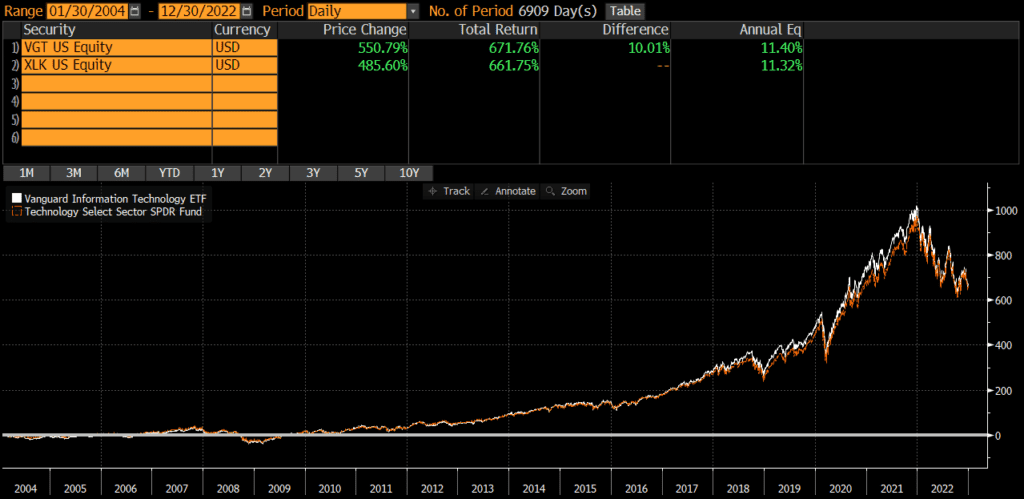The Vanguard Information Technology Index Fund ETF (VGT) and State Street’s The Technology Select Sector SPDR Fund (XLK) are two of the largest information technology sector ETFs and two of the most popular among individual investors. Many investors compare VGT vs XLK because they are so similar. The funds are quite similar with one important difference.
A quick reminder that this site does NOT provide investment recommendations. Fund comparisons (such as this one) are not conducted to identify the “best” fund (since that will vary from investor to investor based on investor-specific factors). Rather, these fund comparison posts are designed to identify and distinguish between the fund details that matter versus the ones that don’t.
The Short Answer
The primary difference between the funds is that XLK is a large-cap fund, while VGT includes mid-caps and small-caps. Despite this difference, risk and return has been nearly identical and I consider these two funds identical and interchangeable.
The Longer Answer
Historical Performance: VGT vs XLK
XLK was launched back in 1998, while VGT was launched in 2004. Since the VGT’s launch, the two funds have performed incredibly similarly, with an annualized difference of only .08%! The cumulative performance differential over that timeframe is roughly 10%.

Portfolio Exposures: VGT vs XLK
XLK tracks the Technology Select Sector Index, which is essentially a sub-index of the S&P 500 (which is predominantly composed of large-caps). It has changed over the years, but the index that VGT currently tracks is includes more mid-caps and small-caps (even though it is also predominantly large-caps).
Geographic Exposure
Both VGT and XLK hold essentially 100% stocks, so I will not dig into country exposures or market classification here. For all intents and purposes, the two funds have identical geographic exposures.
Market Cap Exposure
As the below data illustrates, XLK primarily holds large-caps, while VGT is a bit more diversified in terms of market cap. Despite this difference, both funds are market-cap weighted and risk/return is overwhelmingly driven by the large-cap exposure.
| XLK | VGT | |
| Large Cap | 93% | 84% |
| Mid Cap | 5% | 12% |
| Small Cap | 0% | 5% |
Sector Exposure
VGT and XLK are information technology ETFs and so their holdings are 100% information technology stocks.
Practical Factors: VGT vs XLK
Transaction Costs
As ETFs, both XLK and VGT are free to trade on many platforms. Bid-ask spreads for both VGT and XLK are extremely low and volume is sufficient to prevent most individual investors from “moving the market.”
Expenses
The expense ratio for both XLK and VGT is .10%. At these low levels of expense ratios, small differences in expense ratios does not typically matter anyways. Something to keep in mind if one fund or the other decides to reduce fees.
Tax Efficiency & Capital Gain Distributions
Neither VGT nor XLK has ever made a capital gains distribution and I do not expect them to make any moving forward. In my opinion, these two funds are equally tax-efficient.
Options Strategies
The one factor that may sway someone towards XLK is if they are managing some type of option strategy, such as covered calls. The options market for XLK is much more active than for VGT. Of course, if someone wants to trade options without triggering tax consequences in another part of their portfolio, perhaps VGT is the better pick for the non-option holding.
Bottom Line: VGT vs XLK
VGT and XLK are identical in nearly every way and I would not spend any time comparing them or trying to decide which is better. I believe investors’ time is better spent evaluating and thinking through more material decisions.